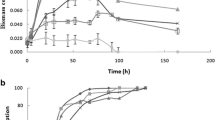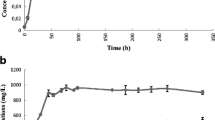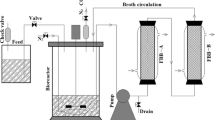Abstract
The effect of acetic acid and formic acid on acetone-butanol-ethanol (ABE) production by solventogenic Clostridia was investigated. The ABE concentration in Clostridium acetobutylicum was found to have increased slightly on addition of 3.7 ∼ 9.7 g/L acetic acid, but was found to have drastically reduced in the presence of 11.7 g/L acetic acid. However, the solvent production of C. beijerinckii was not affected by addition of acetic acid in the range of 3.7 ∼ 11.7 g/L. C. acetobutylicum was more vulnerable to formic acid than C. beijerinckii. In C. acetobutylicum, the total ABE production decreased to 77% on addition of 0.4 g/L formic acid and 25% with 1.0 g/L formic acid. The total ABE production by C. acetobutylicum was also noted to have decreased from 15.1 to 8.6 g/L when 8.7 g/L acetic acid and 0.4 g/L formic acid co-existed. The solvent production by C. beijerinckii was not affected at all under the tested concentration range of formic acid (0.0 ∼ 1.0 g/L) and co-presence of acetic acid and formic acid. Therefore, C. beijerinckii is more favorable than C. acetobutylicum when the ABE is produced using lignocellulosic hydrolysate containing acetic and formic acid.
Similar content being viewed by others
References
Palmqvist, E. and B. Hahn-Hagerdal (2000) Fermentation of lignocellulosic hydrolysates. II: Inhibitors and mechanisms of inhibition. Bioresour. Technol. 74: 25–33.
Pienkos, P. and M. Zhang (2009) Role of pretreatment and conditioning processes on toxicity of lignocellulosic biomass hydrolysates. Cellulose. 16: 743–762.
Sjöström, E. (1993) Wood Chemistry-fundamentals and application. 2nd ed., Academic Press, San Diego.
Dunlop, A. P. (1948) Furfural formation and behaviour. Ind. Eng. Chem. 40: 204–209.
Ulbricht, R. J., S. J. Northup, and J. A. Thomas (1984) A review of 5-hydroxymethylfurfural (HMF) in parenteral solutions. Toxicol. Sci. 4: 843–853.
Russell, J. B. (1992) Another explanation for the toxicity of fermentation acids at low pH: anioin accumulation versus uncoupling. J. Appl. Bacteriol. 73: 363–370.
Axe, D. D. and J. E. Bailey (1995) Transport of lactate and acetate through the energized cytoplasmic membrane of Escherichia coli. Biotechnol. Bioeng. 47: 8–19.
Husemann, M. H. and E. T. Papoutsakis (1990) Effects of propionate and acetate additions on solvent production in batch cultures of Clostridium acetobutylicum. Appl. Environ. Microbiol. 56: 1497–1500.
Chen, C. K. and H. P. Blaschek (1999) Acetate enhances solvent production and prevents degeneration in Clostridium beijerinckii BA101. Appl. Microbiol. Biotechnol. 52: 170–173.
Chen, C. -K. and H. P. Blaschek (1999) Effect of acetate on molecular and physiological aspects of Clostridium beijerinckii NCIMB 8052 solvent production and strain degeneration. Appl. Environ. Microbiol. 65: 499–505.
Wang, S., Y. Zhang, H. Dong, S. Mao, Y. Zhu, R. Wang, G. Luan, and Y. Li (2011) Formic acid triggers the “acid crash” of acetonebutanol-ethanol fermentation by Clostridium acetobutylicum. Appl. Environ. Microbiol. 77: 1674–1680.
Cho, D. H., S. -J. Shin, Y. Bae, C. Park, and Y. H. Kim (2010) Enhanced ethanol production from deacetylated yellow poplar acid hydrolysate by Pichia stipitis. Bioresour. Technol. 101: 4947–4951.
Cho, D. H., S. -J. Shin, Y. Bae, C. Park, and Y. H. Kim (2011) Ethanol production from acid hydrolysates based on the construction and demolition wood waste using Pichia stipitis. Bioresour. Technol. 102: 4439–4443.
Cho, D. H., Y. H. Kim, B. -R. Kim, J. -M. Park, Y. J. Sung, and S. -J. Shin (2011) Kinetic study of xylan hydrolysis and decomposition in concentrated sulfuric acid hydrolysis process by 1HNMR spectroscopy. J. Kor. TAPPI. 43: 52–58.
Maddox, I. S., E. Steiner, S. Hirsch, S. Wessner, N. A. Gutierrez, J. R. Gapes, and K. C. Schuster (2000) The cause of “acid crash” and “acidogenic fermentations” during the batch acetonebutanol-ethanol (ABE-) fermentation process. J. Mol. Microbiol. Biotechnol. 2: 95–100.
Calusinska, M., T. Happe, B. Joris, and A. Wilmotte (2010) The surprising diversity of clostridial hydrogenases: A comparative genomic perspective. Microbiol. 156: 1575–1588.
Bryant, D. L. and H. P. Blaschek (1988) Buffering as a means for increasing growth and butanol production by Clostridium acetobutylicum. J. Ind. Microbiol. Biotechnol. 3: 49–55.
Author information
Authors and Affiliations
Corresponding authors
Rights and permissions
About this article
Cite this article
Cho, D.H., Shin, SJ. & Kim, Y.H. Effects of acetic and formic acid on ABE production by Clostridium acetobutylicum and Clostridium beijerinckii . Biotechnol Bioproc E 17, 270–275 (2012). https://doi.org/10.1007/s12257-011-0498-4
Received:
Revised:
Accepted:
Published:
Issue Date:
DOI: https://doi.org/10.1007/s12257-011-0498-4




